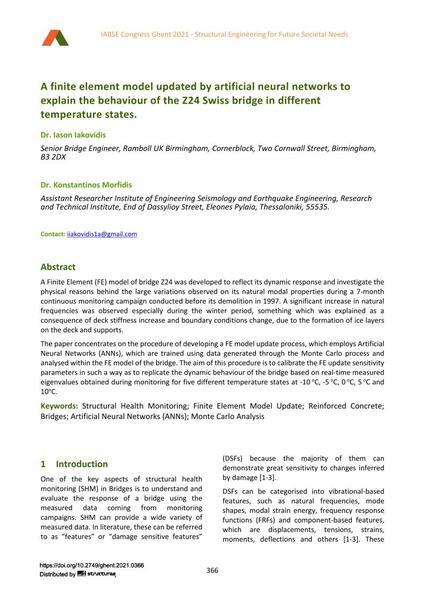A finite element model updated by artificial neural networks to explain the behaviour of the Z24 Swiss bridge in different temperature states.

|
|
|||||||||||
Détails bibliographiques
| Auteur(s): |
Iason Iakovidis
(Senior Bridge Engineer, Ramboll UK Birmingham, Cornerblock, Two Cornwall Street, Birmingham, B3 2DX)
Konstantinos Morfidis (Assistant Researcher Institute of Engineering Seismology and Earthquake Engineering, Research and Technical Institute, End of Dassylioy Street, Eleones Pylaia, Thessaloniki, 55535.) |
||||
|---|---|---|---|---|---|
| Médium: | papier de conférence | ||||
| Langue(s): | anglais | ||||
| Conférence: | IABSE Congress: Structural Engineering for Future Societal Needs, Ghent, Belgium, 22-24 September 2021 | ||||
| Publié dans: | IABSE Congress Ghent 2021 | ||||
|
|||||
| Page(s): | 366-375 | ||||
| Nombre total de pages (du PDF): | 10 | ||||
| DOI: | 10.2749/ghent.2021.0366 | ||||
| Abstrait: |
A Finite Element (FE) model of bridge Z24 was developed to reflect its dynamic response and investigate the physical reasons behind the large variations observed on its natural modal properties during a 7-month continuous monitoring campaign conducted before its demolition in 1997. A significant increase in natural frequencies was observed especially during the winter period, something which was explained as a consequence of deck stiffness increase and boundary conditions change, due to the formation of ice layers on the deck and supports. The paper concentrates on the procedure of developing a FE model update process, which employs Artificial Neural Networks (ANNs), which are trained using data generated through the Monte Carlo process and analysed within the FE model of the bridge. The aim of this procedure is to calibrate the FE update sensitivity parameters in such a way as to replicate the dynamic behaviour of the bridge based on real-time measured eigenvalues obtained during monitoring for five different temperature states at -10°C, -5°C, 0°C, 5°C and 10°C. |
||||
| Mots-clé: |
ponts
|
||||
| Copyright: | © 2021 International Association for Bridge and Structural Engineering (IABSE) | ||||
| License: | Cette oeuvre ne peut être utilisée sans la permission de l'auteur ou détenteur des droits. |
||||
